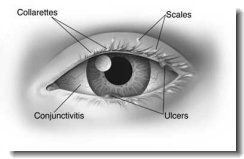
Blepharitis: What is it?
Symptoms You May Experience:
Examination: What Your Eye Doctor Will Look For:
What You Can Do:
When To Call Your M.D.:
Treatment:
Prognosis: Will I See Better?
Blepharitis means inflammation of the eyelid margins, or edges where the eyelashes grow. This condition is one of the most common causes of eye irritation. Blepharitis can result from bacterial infection, abnormal oil gland secretions, or a combination of both. In bacterial blepharitis, certain bacteria live in the eyelids and cause irritation. Abnormal oil gland secretions result when the eyelid glands that make oil for the normal tear film produce too much oil that is overly thick, also causing eye irritation. Blepharitis is often found in patients whith dry eye syndrome and rosacea. Moderate to severe blepharitis can cause irritation of the conjunctiva and the cornea, as the eyelids rub against the surface of the eyeball.
You may notice eye burning, itching, mild redness, the feeling that something is in the eye, or crusting around the eylashes that is particularly worse upon awakening.
Your eye doctor will examine your eyes with a slit lamp to look for crusting and debris around the base of your eyelashes, as well as clogging of your eyelid oil glands. He or she will look for signs of corneal or conjunctival irritation, as well as signs of dry eye.
If you notice mild symptoms of eye irritation, you can try the following lid hygiene techniques:
1. Moisten a clean cloth with warm water, wring out the excess, and use the washcloth as a warm compress for your eyelids while keeping your eyes closed. This should be done twice daily for at least five minutes at a time.
2. After using the warm compress, place a drop of tear-free baby shampoo on the damp washcloth and use it to gently massage the base of your eyelashes while your eyes are closed. Rinse afterward.
Also, preservative-free artificial tear drops, which are available over the counter, can be used as frequently as necessary.
1. Moisten a clean cloth with warm water, wring out the excess, and use the washcloth as a warm compress for your eyelids while keeping your eyes closed. This should be done twice daily for at least five minutes at a time.
2. After using the warm compress, place a drop of tear-free baby shampoo on the damp washcloth and use it to gently massage the base of your eyelashes while your eyes are closed. Rinse afterward.
Also, preservative-free artificial tear drops, which are available over the counter, can be used as frequently as necessary.
If your symptoms of eye irritation are not improved with lid hygiene or artificial tears, or if your symptoms are severe, call your eye doctor. If you notice decreased vision or eye discharge, call your eye doctor promptly, since these symptoms may signify a more serious eye problem.
Besides recommending lid hygiene and preservative-free artificial tears, your eye doctor may prescribe antibiotic ointment to be applied to the edges of your eye lids if the blepharitis is moderate to severe. In some cases that do not improve, he or she may prescribe an antibiotic, such as doxycycline, to be taken by mouth for several weeks. Rarely, steroid eye drops may be necessary for a short course.
Blepharitis is a chronic condition that can be controlled but is usually not completely cured. Lid hygiene techniques may need to be performed consistently for days to weeks before you notice less eye irritation, and antibiotic courses may also need to be repeated over time. With faithful use of these treatments, however, most patients will notice an improvement in their symptoms.

Contact Lenses | Glaucoma | Just For Fun | Eyeglasses | Eye Doctor | Eye Care And Symptoms | Eye Anatomy | Online Eye Tests | Laser Eye Surgery | Laser Eye Surgery Directory: Canada | Laser Eye Surgery Directory: USA | Laser Eye Surgery Reviews | Submit A Review | Contact Us | Privacy Policy | Sitemap
Copyright 2006-2009 Vision Health

